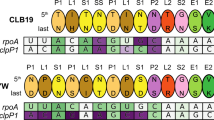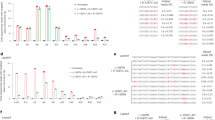Abstract
RNA editing is a process of RNA maturation involved in the insertion, deletion or modification of nucleotides1. In organellar transcripts of higher plants, specific cytidine residues are converted into uridine residues. In many cases, editing results in the restoration of conserved amino acid residues, a process that is essential for protein function in plastids2,3. Despite the technical breakthrough in establishing systems in vivo4 and in vitro5 for analysing RNA editing, its machinery still remains to be identified in higher plants. Here we introduce a genetic approach and report the discovery of a gene responsible for the specific RNA editing event in the chloroplast.
This is a preview of subscription content, access via your institution
Access options
Subscribe to this journal
Receive 51 print issues and online access
$199.00 per year
only $3.90 per issue
Buy this article
- Purchase on Springer Link
- Instant access to full article PDF
Prices may be subject to local taxes which are calculated during checkout




Similar content being viewed by others
References
Smit, H. C., Gott, J. M. & Hanson, M. R. A guide to RNA editing. RNA 3, 1105–1123 (1997)
Bock, R., Kössel, H. & Maliga, P. Introduction of a heterologous editing site into the tobacco plastid genome: the lack of RNA editing leads to a mutant phenotype. EMBO J. 13, 4623–4628 (1994)
Sasaki, Y., Kozaki, A., Ohmori, A., Iguchi, H. & Nagano, Y. Chloroplast RNA editing required for functional acetyl-CoA carboxylase in plants. J. Biol. Chem. 276, 3937–3940 (2000)
Chaudhuri, S., Carrer, H. & Maliga, P. Site-specific factor involved in the editing of the psbL mRNA in tobacco plastids. EMBO J. 14, 2951–2957 (1995)
Hirose, T. & Sugiura, M. Involvement of a site-specific trans-acting factor and a common RNA-binding protein in the editing of chloroplast mRNAs: development of a chloroplast in vitro RNA editing system. EMBO J. 20, 1144–1152 (2001)
Shikanai, T. et al. Directed disruption of the tobacco ndhB gene impairs cyclic electron flow around photosystem I. Proc. Natl Acad. Sci. USA 95, 9705–9709 (1998)
Munekage, Y. et al. Cyclic electron flow around photosystem I is essential for photosynthesis. Nature 429, 579–582 (2004)
Hashimoto, M., Endo, T., Peltier, G., Tasaka, M. & Shikanai, T. A nucleus-encoded factor, CRR2, is essential for the expression of chloroplast ndhB in Arabidopsis. Plant J. 36, 541–549 (2003)
Shikanai, T., Munekage, Y., Shimizu, K., Endo, T. & Hashimoto, T. Identification and characterization of Arabidopsis mutants with reduced quenching of chlorophyll fluorescence. Plant Cell Physiol. 40, 1134–1142 (1999)
Aubourg, S., Boudet, N., Kreis, M. & Lecharny, A. In Arabidopsis thaliana, 1% of the genome codes for a novel protein family unique to plants. Plant Mol. Biol. 42, 603–613 (2000)
Small, I. D. & Peeters, N. The PPR motif—a TPR-related motif prevalent in plant organellar proteins. Trends Biochem. Sci. 25, 46–47 (2000)
Lurin, C. et al. Genome-wide analysis of Arabidopsis pentatricopeptide repeat proteins reveals their essential role in organelle biogenesis. Plant Cell 16, 2089–2103
Fisk, D. G., Walker, M. B. & Barkan, A. Molecular cloning of the maize gene crp1 reveals similarity between regulators of mitochondrial and chloroplast gene expression. EMBO J. 18, 2621–2630 (1999)
Meierhoff, K., Felder, S., Nakamura, T., Bechtold, N. & Schuster, G. HCF152, an Arabidopsis RNA binding pentatricopeptide repeat protein involved in the processing of chloroplast psbB-psbT-psbH-petB-petD RNAs. Plant Cell 15, 1480–1495 (2003)
Yamazaki, H., Tasaka, M. & Shikanai, T. PPR motifs of the nucleus-encoded factor, PGR3, function in the selective and distinct steps of chloroplast gene expression in Arabidopsis. Plant J. 38, 152–163 (2004)
Williams, P. M. & Barkan, A. A chloroplast-localized PPR protein required for plastid ribosome accumulation. Plant J. 36, 675–686 (2003)
Manthey, M. G. & McEwen, J. E. The product of the nuclear gene PET309 is required for translation of mature mRNA and stability or production of intron-containing RNAs derived from the mitochondrial COX1 locus of Saccharomyces cerevisiae. EMBO J. 14, 4031–4043 (1995)
Coffin, J. W., Dhillon, R., Ritzel, R. G. & Nargang, F. E. The Neurospora crassa cya-5 nuclear gene encodes a protein with a region of homology to the Saccharomyces cerevisiae PET309 protein and is required in a post-transcriptional step for the expression of the mitochondrially encoded COXI protein. Curr. Genet. 32, 273–280 (1997)
Bentolila, S., Alfonso, A. A. & Hanson, M. R. A pentatricopeptide repeat-containing gene restores fertility to cytoplasmic male-sterile plants. Proc. Natl Acad. Sci. USA 99, 10887–10892 (2002)
Kazama, T. & Toriyama, K. A pentatricopeptide repeat-containing gene that promotes the processing of aberrant atp6 RNA of cytoplasmic male-sterile rice. FEBS Lett. 544, 99–102 (2003)
Koizuka, N. et al. Genetic characterization of a pentatricopeptide repeat protein gene, orf687, that restores fertility in the cytoplasmic male-sterile Kosena radish. Plant J. 34, 407–415 (2003)
Lutz, K. A. & Maliga, P. Lack of conservation of editing sites in mRNAs that encode subunits of the NAD(P)H dehydrogenase complex in plastids and mitochondria of Arabidopsis thaliana. Curr. Genet. 40, 214–219 (2001)
Neckermann, K., Zeltz, P., Igloi, G. L., Kössel, H. & Maier, R. M. The role of RNA editing in conservation of start codons in chloroplast genomes. Gene 146, 177–182 (1994)
Hirose, T. & Sugiura, M. Both RNA editing and RNA cleavage are required for translation of tobacco chloroplast ndhD mRNA: a possible regulatory mechanism for the expression of a chloroplast operon consisting of functionally unrelated genes. EMBO J. 16, 6804–6811 (1997)
del Campo, E. M., Sabater, B. & Martin, M. Post-transcriptional control of chloroplast gene expression. Accumulation of stable psaC mRNA is due to downstream RNA cleavages in the ndhD gene. J. Biol. Chem. 277, 36457–36464 (2002)
Chateigner-Boutin, A.-L. & Hanson, M. R. Developmental co-variation of RNA editing extent of plastid editing sites exhibiting similar cis-elements. Nucleic Acids Res. 31, 2586–2594 (2003)
Guera, A., Nova, P. G. & Sabater, B. Identification of the Ndh (NAD(P)H-plastoquinone-oxidoreductase) complex in etioplast membranes of barley: changes during photomorphogenesis of chloroplasts. Plant Cell Physiol. 41, 49–59 (2000)
Keegan, L. P., Gallo, A. & O'Connell, M. A. The many roles of an RNA editor. Nature Rev. Genet. 2, 869–878 (2001)
Miyamoto, T., Obokata, J. & Sugiura, M. A site-specific factor interacts directly with its cognate RNA editing site in chloroplast transcripts. Proc. Natl Acad. Sci. USA 101, 48–52 (2004)
Glegé, P. & Brennicke, A. RNA editing in Arabidopsis mitochondria effects 441 C to U changes in ORFs. Proc. Natl Acad. Sci. USA 96, 15324–15329 (1999)
Acknowledgements
We thank M. Miyata and E. Habe for their technical assistance; T. Endo, G. Peltier and the late A. Watanabe for antibodies; and J. Obokata for suggestions. T. Shikanai was supported by grants from JSPS and Ministry of Education, Sports, Culture, Science and Technology, Japan.
Author information
Authors and Affiliations
Corresponding author
Ethics declarations
Competing interests
The authors declare that they have no competing financial interests.
Supplementary information
Supplementary Figure S1
RNA protection assay. (GIF 47 kb)
Supplementary Figure Legend
Legend to accompany Supplementary Figure S1. (DOC 21 kb)
Supplementary Methods
This contains details of the methods for the quantitative analysis of RNA editing and the determination if RNA ends. (DOC 20 kb)
Supplementary Tables
Contains Supplementary Tables S1-S3. Supplementary Table S1 details the efficiency of the RNA editing in ndhD initiation codon. Supplementary Table S2 details the RNA editing extents in ndh genes. Supplementary Table S3 lists the oligonucleotides used in the study. (DOC 42 kb)
Rights and permissions
About this article
Cite this article
Kotera, E., Tasaka, M. & Shikanai, T. A pentatricopeptide repeat protein is essential for RNA editing in chloroplasts. Nature 433, 326–330 (2005). https://doi.org/10.1038/nature03229
Received:
Accepted:
Issue Date:
DOI: https://doi.org/10.1038/nature03229
This article is cited by
-
Gene expression and physiological roles of post-transcriptional editing in plant organellar systems
Theoretical and Experimental Plant Physiology (2024)
-
Effect of salinity on ccmfn gene RNA editing of mitochondria in wild barley and uncommon types of RNA editing
Functional & Integrative Genomics (2023)
-
Salinity stress reveals three types of RNA editing sites in mitochondrial Nad7 gene of wild barley both in silico and in qRT-PCR experiments
Theoretical and Experimental Plant Physiology (2022)
-
DYW domain structures imply an unusual regulation principle in plant organellar RNA editing catalysis
Nature Catalysis (2021)
-
A synthetic RNA editing factor edits its target site in chloroplasts and bacteria
Communications Biology (2021)
Comments
By submitting a comment you agree to abide by our Terms and Community Guidelines. If you find something abusive or that does not comply with our terms or guidelines please flag it as inappropriate.



